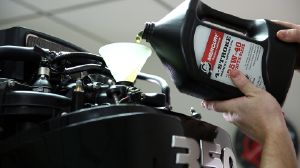Boat Oil Change
There’s one thing that every boat needs and that’s maintenance.
 Fortunately, routine maintenance and even small repairs aren’t that tough and, in the long run, a little elbow grease will definitely pay off.
Fortunately, routine maintenance and even small repairs aren’t that tough and, in the long run, a little elbow grease will definitely pay off.
The first and simplest task is to wash your boat regularly and, if your boat has been in salt water, rinse your boat thoroughly with fresh water after every outing to remove all that saltwater residue.
A long-handled boat brush or a spray one make the job pretty easy. You can find one at your local marine retail store to protect your boat’s finish. Be sure to use soaps and cleaners that are made just for boats. i.e. a marine-grade cleaner.
A clean haul bottom is more fuel efficient than a boat covered with algae or other aquatic scum. A dirty hull can easily add up to 30% to your fuel cost.
Just like cars, a boat needs to have its oil changed. For stroked-out boards and boards stern drive boats require regular oil changes. The frequency will depend on the model but a good rule of thumb is to change the oil every hundred hours or at least once a year. Some boat owners change the oil every 50 hours, especially if they have a diesel.
Unfortunately there aren’t any quickie oil lube shops for boats so you have to change your boat’s oil all yourself or take it to your local dealer. Fortunately changing the oil in your boats engine is quite easy in most cases. Its easier than changing the oil in your car. First start the engine up to warm it up a bit. Then turn it off and remove the drain plug and drain the old oil. Change the filter and replace the drain plug.
Marine Grade Oil for Boat Oil Change
Refer to your engine owner’s manual for the manufacturer’s boat oil change recommendations. Fill the engine with new Marine Grade Oil.
Your boat engine works much harder than car engines and automotive oil isn’t made to protect your marine if you have an outboard our Stern draw boat.
You should check the propeller as part of the pre-launch routine. Use a deep well socket to make sure the propeller nut is nice and secure. You should also remove the propeller several times during the season to make sure your discarded fishing line hasn’t become wrapped around the propeller shaft.
If it is have your dealer inspect the gear case because the fishing line can cause gear case leaks and gear case service is not a do-it-yourself job. While you have the propeller off inspect it for nicks, dings, or other signs of damage. Send it out for repairs if you find the slightest sign of impact as the smallest dent can reduce your boat’s performance by up to 10%..
Finally, put a liberal amount of waterproof grease on the propeller shaft and reinstall the propeller and hardware in the same order that you took them off. Then tighten the propeller nut to the manufacturer’s specifications. obviously, there are maintenance and repair procedures I haven’t touched on but detailed instructions for most Do-it-yourself jobs are readily available.
The bottom line is there is no reason to be intimidated by working on your boat. Take your time and you may find you can do more than you thought possible. Good luck out there take care of that boat and we’ll see out in the water.
MarineBatteryGuide.com is a participant in the Amazon Services LLC Associates Program, an affiliate advertising program designed to provide a means for sites to earn advertising fees by advertising and linking to Amazon.com,
Links on this boat oil change page are sponsored affiliate links and the owner makes commission if you buy after clicking these links. The owner is not a bona-fide user of boat oil change products. However, he has thoroughly researched it and provided a personal opinion only. This disclosure is in accordance with the Federal Trade Commission’s 16 CFR, Part 255: “Guides Concerning the Use of Endorsements and Testimonials in Advertising.”
Filed under: Buying Advice

